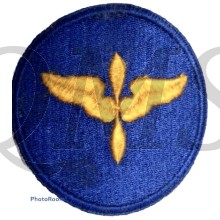Mouw embleem Army Air Force Cadet
The Flying / Aviation Cadet Pilot Training Program was created by the US Army to train its pilots. Originally created in 1907 by the US Army Signal Corps, it expanded as the Army's air assets increased. Candidates originally had to be between the ages of 19 and 25, athletic, and honest. Two years of college or three years of a scientific or technical education were required. Cadets were supposed to be unmarried and pledged not to marry during training. From 1907 to 1920, pilot officers were considered part of the Signal Corps or the Signal Officer Reserve Corps. After 1920, they were considered part of their own separate organization, the US Army Air Service (1918–1926).
The US Army Air Corps Training Center (USAACTC) was at Duncan Field from 1926 to 1931 andRandolph Field from 1931 to 1939. Two more centers were activated on 8 July 1940: the West Coast Army Air Corps Training Center (WCAACTC) in Sunnyvale, California and the Southeast Army Air Corps Training Center (SAACTC) in Montgomery Alabama. The USAACTC was renamed the Gulf Coast Army Air Corps Center (GCAACTC). In 1942 the Army moved the WCAACTC from Moffett Field to Santa Ana Army Air Base (SAAAB), located on West 8th Street in Santa Ana, California.
Aviation cadet centers:
- Gulf Coast Army Air Corps Center (GCAACTC)– Randolph Field, San Antonio, Texas (1931–47).
- West Coast Army Air Corps Training Center (WCAACTC) – Moffett Field, Sunnyvale, California (1940–41). Santa Ana Army Air Base (SAAAB); Santa Ana, California (1942–1947).
- Southeast Army Air Corps Training Center (SAACTC) – Maxwell Field, Montgomery, Alabama (1940–47). From 1942, classification and pre-flight took place at Nashville AAC,Tennessee.
From 1947, it was run by the now-independent US Air Force from Lackland, Kelly, Randolph, orBrooks AFB. The Air Force program stopped taking civilian and enlisted pilot candidates in 1961 and navigator candidates in 1965.



